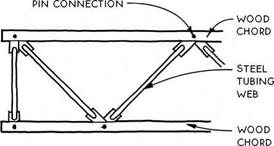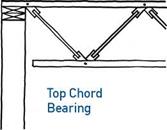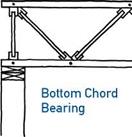@ WOOD FLOOR TRUSSES



Wood top and bottom chords are linked with steel tubing webs in the composite truss. The tubing is pressed flat at the ends and connected to the wood chords with a metal pin. Unlike wood trusses with metal plates (see 45A above), the webs of the composite truss are entirely free to rotate (on the pins) and therefore allow the truss to return to its original shape when the load is removed.
Composite trusses are generally more heavy duty than their all-wood cousins illustrated in 45A above. The largest composite trusses are capable of spanning
over 100 ft. They are made with double 2x chords, which sandwich the webs. The lightest-duty composite trusses are made with single 2×4 chords oriented flat and dadoed to receive the webs.
Like wood floor trusses, composite trusses easily accommodate ducts and other utilities, which can be run through the open webs without altering the truss. Like all trusses, composite trusses are most practical for simple plans with long spans. Once engineered and installed, they are difficult to alter.






Leave a reply